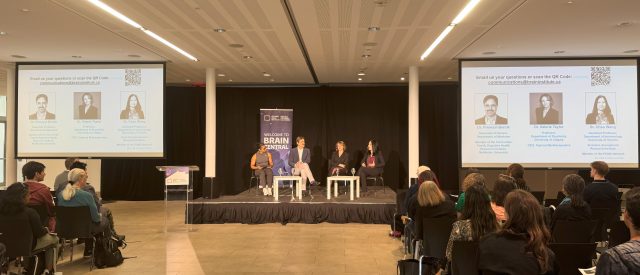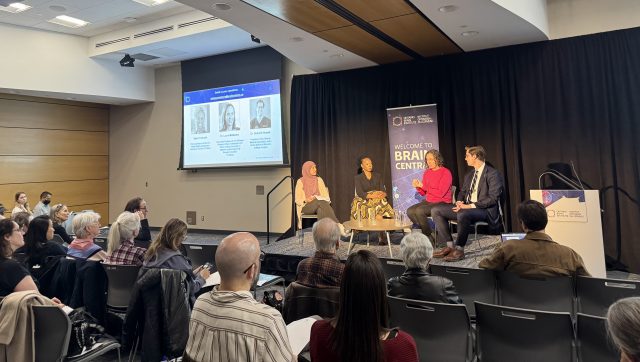Defining young-onset dementia
Dementia is a brain condition that involves a progressive loss of thinking, memory, and other mental abilities. The memory and cognitive dysfunction significantly affects a person’s daily life and results in reliance on others for their day-to-day tasks.
Young or early-onset dementia refers to dementia symptoms diagnosed in a person who is under the age of 65. It is estimated that 2%-10% of people diagnosed with dementia are under 65 years of age. At this earlier stage of life, people are typically still working, may have young families and other differing life circumstances from people who are diagnosed at 65 or older. As such, the lost work-year productivity measures, the psychosocial distress factors, and the impacts on the healthcare system for this group are different than those for late onset dementia and are indeed significant.
People living with young onset dementia often present differently than those who present later in life, making for a potentially more complex process of diagnosis. The importance of an accurate diagnosis, along with identifying the right causes of the condition cannot be understated, particularly as some causes can potentially be treated. This can lead to important implications for counselling affected individuals and their families.
A guide for diagnosing young onset dementia
When a person presents with cognitive impairment, a thorough clinical history followed by detailed general and neurological exams are the necessary first steps to an accurate diagnosis. Using a systematic approach, the goal is to rule out any potentially treatable conditions and to identify associated clinical features that may help hone in on an accurate diagnosis. Special attention should also be paid to family history, the presence of infectious diseases (e.g., HIV) and exposures to various toxins (e.g., heavy alcohol use).
Cognitive screening with specialized tests to assess memory and thinking abilities should be done as part of this initial assessment. It is important to ensure that the tests used are appropriate and have been validated for the target population. Specific patterns of cognitive damage identified on testing may assist with the accurate diagnosis.
Basic blood work should be included in this early assessment. The focus of the blood work is to see if potentially treatable causes of the impairment are present. These can include issues such as anaemia, vitamin B12 or other vitamin deficiencies, or thyroid abnormalities.
Brain imaging should also be done to rule out structural or other abnormalities that are visible, including stroke and brain tumours. If these are absent, then neuroimaging profiles can help differentiate amongst different causes of dementia.
A spinal tap may also be considered to rule out infectious or inflammatory causes of symptoms, which could potentially be treatable. It is also now possible to identify spinal fluid changes supportive of a diagnosis of Alzheimer’s disease. More specialized laboratory testing, such as evaluating for genetic mutations that run in an affected individual’s family, may also be helpful in making a diagnosis.
+++
Are the causes of young-onset dementia different than late onset?
Neurodegenerative diseases1, such as Alzheimer’s disease, are still the most common causes of dementia in this age group. Reversible or treatable causes are relatively more common in young-onset dementia than late onset and need to be ruled out. Determining a specific familial (i.e., genetic) inheritance pattern is crucial in guiding appropriate specialized investigations. A referral to a clinical geneticist or genetics counsellor may be advisable in some circumstances. Rare genetic or metabolic disorders2 as a cause can sometimes be diagnosed by specialized genetic testing through this route.
Neurodegeneration and other factors contributing to dementia
Early-onset Alzheimer’s disease is the most common neurodegenerative cause of dementia in the young; familial Alzheimer’s disease due to genetic mutations, while uncommon, is still more frequent in this age group than in the late-onset groups. Memory loss is the most common clinical presentation of early-onset Alzheimer’s disease. However, in many cases, variants of the Alzheimer’s disease that also include other symptoms, such as language, or behavioural/executive problems, occur more frequently in early onset than in late-onset forms.
Frontotemporal dementia is the second most common neurodegenerative cause of dementia in this age group. People in this group present early on with either prominent behavioural or language irregularities. Frontotemporal dementia is more strongly genetic than young-onset Alzheimer’s disease and several disease-causing mutations have been identified.
Parkinson-Lewy body spectrum disorders represent another related group of conditions that can cause dementia in the young. People may additionally present with motor symptoms that affect their walking, cause muscles to be rigid, cause tremors and a variety of other symptoms.
There is a strong link between poorly controlled cardiovascular risk factors (including hypertension, diabetes, high cholesterol, and smoking) and dementia. Mixed disease, that is diseases of the brain’s blood vessels in conjunction with neurodegenerative diseases, like Alzheimer’s disease, are the most common form of late-onset dementia. This pattern of mixed disease is less prevalent in young-onset dementia, but is rising, particularly in low- to middle-income countries. Since cardiovascular risk factors are modifiable, there is hope that managing them with medications and lifestyle interventions might reduce the incidence of dementia.
Conditions that can lead to poor sleep, can cause inflammation of the brain, or lead to seizures should not be missed since these are potentially treatable causes of cognitive impairment in the young.
More on infectious diseases
While neurodegenerative causes of young-onset dementia are prevalent in low- and middle-income countries, infectious diseases are an important contributor to cognitive dysfunction due to their higher prevalence in these geographical regions. The prevalence of a particular infection in a region (such as HIV) should be determined when ordering specific microbiological diagnostic tests.
Summary
Young-onset dementia poses unique challenges for people living with this condition, their families, healthcare systems and society overall. A thorough approach to diagnosis is needed to ensure that treatable contributing factors or causes of dementia are addressed if present; if not, then neurodegenerative causes of the symptoms need to be identified. Access to genetic counselling and other specialized care services should be provided by healthcare systems if possible. A detailed family history should be ascertained to determined if a genetic disorder is in fact present.
Masellis M., “What is the most efficient way to diagnose dementia in a young person?” In: Gauthier S, Rosa-Neto P, Morais JA, & Webster C., “World Alzheimer Report 2021: Journey through the diagnosis of dementia”. London, England: Alzheimer’s Disease International; 2021.
Access the full report here.



